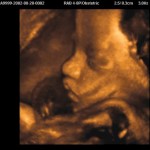Home >> Prenatal control, The baby week by week >> Week 39. Meconium. The umbilical cord
Week 39. Meconium. The umbilical cord
 At this point, the baby swallows amniotic liquid and begins to accumulate it as waste material, this material is called meconium. Meconium is a sticky black substance that will be its first internal movement after the birth. All in all, this the first poop.
At this point, the baby swallows amniotic liquid and begins to accumulate it as waste material, this material is called meconium. Meconium is a sticky black substance that will be its first internal movement after the birth. All in all, this the first poop.
The umbilical cord, which until now has transported the nutrients from the placenta to the baby, is now about 50 centimetres long and 1.3 centimetres wide. As the baby takes up all the space in the uterus, it is common for the umbilical cord to be coiled around the baby. The umbilical cord is very elastic and usually it does not cause a lot of trouble. Even so, there are cases in which the baby can be born with the cord surrounding its neck. Don’t worry, childbirths after more than 35 weeks pregnancy are nowadays easy, as well as to cut the umbilical cord too.
Nobody knows what exactly triggers the childbirth. What we know for sure is that the baby’s lungs and your placenta are the key factors for the synchronization. When lungs are mature, they secrete a protein into the amniotic liquid that alters the production of hormones. This change causes the placenta to reduce the emission of the progesterone hormone and foments the production of the new hormone: the oxytocin. The oxytocin regulates the contractions of the uterus and indicates the child is going to be born. It also blocks your memories and helps you to forget the pain.
Waters can break at any time. Go to the hospital, call your doctor or prepare everything to have the childbirth you have planned (conventional, natural, water birth…).
Tags: baby, changes, development, embryo, fetus, gestation, growth, pregnancy, week 39